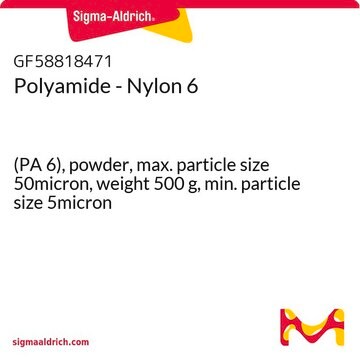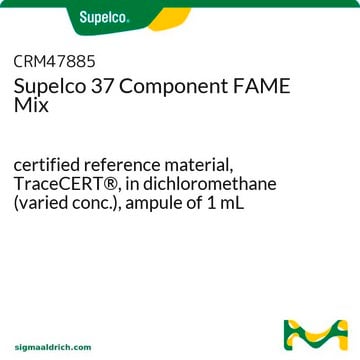The purity of this product can be roughly calculated from the phosphorus content (on a dried basis) and the sodium number provided on the Certificate of Analysis (COA). The minimum specification for purity is > 79% on a dried basis. To prepare a stock solution of this product, it is suggested to dry the product (e.g. 100°C overnight) to thoroughly remove the water of hydration, then accurately weigh the desired amount of the dried phytic acid sodium salt, then add a specific volume of distilled or deionized water to the weighed compound, finally stir the solution until the phytic acid sodium salt is completely dissolved.
P8810
Ácido fítico sodium salt hydrate
from rice
Sinónimos:
mio-inositol hexakis (fosfato de dihidrógeno), Hexakisfosfato de inositol, InsP6, Ácido hexafosfórico de inositol
Seleccione un Tamaño
US$ 189,00
Disponible para envío el07 de abril de 2025Detalles
Seleccione un Tamaño
About This Item
US$ 189,00
Disponible para envío el07 de abril de 2025Detalles
Productos recomendados
origen biológico
rice
Formulario
powder
composición
Sodium (Na), ≥5 mol/mol
solubilidad
water: soluble
trazas de catión
Ca: ≤2%
temp. de almacenamiento
room temp
cadena SMILES
[Na+].[Na+].[Na+].[Na+].[Na+].[Na+].[Na+].[Na+].[Na+].[Na+].[Na+].[Na+].[O-]P([O-])(=O)O[C@H]1[C@H](OP([O-])([O-])=O)[C@H](OP([O-])([O-])=O)[C@H](OP([O-])([O-])=O)[C@@H](OP([O-])([O-])=O)[C@@H]1OP([O-])([O-])=O
InChI
1S/C6H18O24P6.12Na/c7-31(8,9)25-1-2(26-32(10,11)12)4(28-34(16,17)18)6(30-36(22,23)24)5(29-35(19,20)21)3(1)27-33(13,14)15;;;;;;;;;;;;/h1-6H,(H2,7,8,9)(H2,10,11,12)(H2,13,14,15)(H2,16,17,18)(H2,19,20,21)(H2,22,23,24);;;;;;;;;;;;/q;12*+1/p-12
Clave InChI
KETSPIPODMGOEJ-UHFFFAOYSA-B
¿Está buscando productos similares? Visita Guía de comparación de productos
Descripción general
Aplicación
Acciones bioquímicas o fisiológicas
Nota de análisis
Otras notas
Código de clase de almacenamiento
13 - Non Combustible Solids
Clase de riesgo para el agua (WGK)
WGK 3
Punto de inflamabilidad (°F)
Not applicable
Punto de inflamabilidad (°C)
Not applicable
Equipo de protección personal
Eyeshields, Gloves, type N95 (US)
Elija entre una de las versiones más recientes:
Certificados de análisis (COA)
¿No ve la versión correcta?
Si necesita una versión concreta, puede buscar un certificado específico por el número de lote.
¿Ya tiene este producto?
Encuentre la documentación para los productos que ha comprado recientemente en la Biblioteca de documentos.
-
What is the purity percent of phytic acid sodium salt hydrate P8810? How to make stock solution using this?
1 answer-
Helpful?
-
-
How is shipping temperature determined? And how is it related to the product storage temperature?
1 answer-
Products may be shipped at a different temperature than the recommended long-term storage temperature. If the product quality is sensitive to short-term exposure to conditions other than the recommended long-term storage, it will be shipped on wet or dry-ice. If the product quality is NOT affected by short-term exposure to conditions other than the recommended long-term storage, it will be shipped at ambient temperature. As shipping routes are configured for minimum transit times, shipping at ambient temperature helps control shipping costs for our customers. For more information, please refer to the Storage and Transport Conditions document: https://www.sigmaaldrich.com/deepweb/assets/sigmaaldrich/marketing/global/documents/316/622/storage-transport-conditions-mk.pdf
Helpful?
-
-
How can I determine the shelf life / expiration / retest date of this product?
1 answer-
If this product has an expiration or retest date, it will be shown on the Certificate of Analysis (COA, CofA). If there is no retest or expiration date listed on the product's COA, we do not have suitable stability data to determine a shelf life. For these products, the only date on the COA will be the release date; a retest, expiration, or use-by-date will not be displayed.
For all products, we recommend handling per defined conditions as printed in our product literature and website product descriptions. We recommend that products should be routinely inspected by customers to ensure they perform as expected.
For products without retest or expiration dates, our standard warranty of 1 year from the date of shipment is applicable.
For more information, please refer to the Product Dating Information document: https://www.sigmaaldrich.com/deepweb/assets/sigmaaldrich/marketing/global/documents/449/386/product-dating-information-mk.pdfHelpful?
-
-
Hi, I have sodium phytate (lot: BCCF1452). In COA there is a result about phosphorus 22,2% (dried basis). What is that mean? Is that inorganic phosphorus content? If it is not, how can i calculate the inorganic phosphorus content?
1 answer-
The phosphorus value reported in the product Certificate of Analysis is the total amount. Currently, the inorganic phosphorus is not measured. However, historical data indicates that inorganic phosphorus levels are typically < 0.6 %.
Helpful?
-
Active Filters
Nuestro equipo de científicos tiene experiencia en todas las áreas de investigación: Ciencias de la vida, Ciencia de los materiales, Síntesis química, Cromatografía, Analítica y muchas otras.
Póngase en contacto con el Servicio técnico







